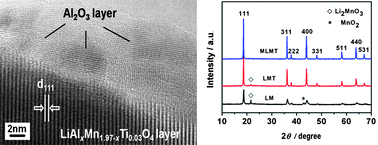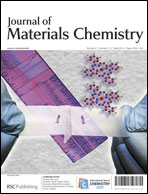Spinel LiMn2O4 is one of the cathode active materials for the rechargeable lithium-ion batteries with the most potential, but suffers from a fast capacity fade when cycling at elevated temperatures (55 °C). Spinel LiMn1.97Ti0.03O4 coated with aluminum nitrate is heat-treated at various temperatures. The sample treated at low temperature (500 °C) exhibits porous Al2O3 layer coated on the surface, and little Al ion diffusing into the spinel structure. As for the sample treated at mid-temperature (700 °C), it exhibits double layers coated on the surface: the inner layer is LiAlxMn1.97−xTi0.03O4 solid solution and the outer layer is compact Al2O3 metal oxides. When the heat-treatment temperature increases to a high level (850 °C), nearly all the Al ion diffusing into the structure to form Al doped solid solution layer coated on the spinel. The relationship between the structure of the modified samples and their electrochemical properties is investigated. The galvanostatic charge–discharge results show that those surface-modified samples exhibit improved cycling performance compared to LiMn1.97Ti0.03O4; and the sample treated at mid-temperature delivers the best capacity retention, especially at 55 °C. The improved cycling performance is ascribed to the coated layers of Al2O3 and LiAlxMn1.97−xTi0.03O4 on the spinel particles. The Al2O3 layer could reduce the HF damage by scavenging of HF. While the LiAlxMn1.97−xTi0.03O4 layer could enhance the stability of the spinel structure due to the stronger Al–O bond; moreover, this coating layer having the same spinel structure with the LiMn1.97Ti0.03O4 core material would not hinder the lithium ion diffusion. The sample treated at mid-temperature has the double layers coated on the surface, and its Al2O3 coating becomes compact and thin which could effectively block the direct contact between the electrolyte and spinel particles as well as reduce the lithium ion diffusion distance in the inactive layer, leading to greatly improved capacity retention.

You have access to this article
 Please wait while we load your content...
Something went wrong. Try again?
Please wait while we load your content...
Something went wrong. Try again?


 Please wait while we load your content...
Please wait while we load your content...